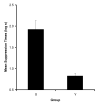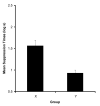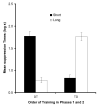Using context to resolve temporal ambiguity
- PMID: 20141323
- PMCID: PMC2829846
- DOI: 10.1037/a0016055
Using context to resolve temporal ambiguity
Abstract
Three conditioned lick suppression experiments with rats examined the role of the context in the selection and integration of independently acquired interval relationships. In Experiment 1, rats were exposed to separate conditioned stimuli 1 and 2 (CS1-CS2) pairings with 2 different interval relationships, each in its own distinctive context, X or Y. The resultant integration was determined by the training context (X or Y) in which unconditioned stimulus (US)-CS2 backward pairings occurred, as assessed in a third neutral context (Z). In Experiment 2, rats experienced CS1-CS2 pairings with 2 different interval relationships as in Experiment 1, and then received US-CS2 pairings in both contexts X and Y. The testing context (i.e., X or Y) determined the resultant integration. In Experiment 3, rats were exposed to CS1-CS2 pairings in 2 different interval relationships each in different phases (i.e., Phases 1 and 2), and then in Phase 3 received US-CS2 pairings. The temporal context of testing (i.e., short or long retention interval) determined the resultant integration. Thus, both physical and temporal context can be used to disambiguate conflicting temporal information.
Figures






Similar articles
-
Effect of low body temperature on associative interference in conditioned taste aversion.Percept Mot Skills. 2005 Jun;100(3 Pt 2):913-9. doi: 10.2466/pms.100.3c.913-919. Percept Mot Skills. 2005. PMID: 16158677
-
Retention of context blocking in taste-aversion learning.Physiol Behav. 1997 Mar;61(3):437-46. doi: 10.1016/s0031-9384(96)00458-1. Physiol Behav. 1997. PMID: 9089764
-
Second-order conditioning and Pavlovian conditioned inhibition: operational similarities and differences.J Exp Psychol Anim Behav Process. 1994 Oct;20(4):419-28. J Exp Psychol Anim Behav Process. 1994. PMID: 7964524
-
Temporal integration and instrumental conditioned reinforcement.Learn Behav. 2014 Sep;42(3):201-8. doi: 10.3758/s13420-014-0138-x. Learn Behav. 2014. PMID: 24879632 Free PMC article.
-
Overshadowing and latent inhibition of context aversion conditioning in the rat.Auton Neurosci. 2006 Oct 30;129(1-2):42-9. doi: 10.1016/j.autneu.2006.07.013. Epub 2006 Aug 28. Auton Neurosci. 2006. PMID: 16935569 Review.
Cited by
-
The role of test context in latent inhibition of conditioned inhibition: Part of a search for general principles of associative interference.Learn Behav. 2015 Sep;43(3):228-42. doi: 10.3758/s13420-015-0175-0. Learn Behav. 2015. PMID: 25875792 Free PMC article.
-
Feature-positive discriminations during a spatial-search task with humans.Learn Behav. 2014 Sep;42(3):215-30. doi: 10.3758/s13420-014-0140-3. Learn Behav. 2014. PMID: 24903597
-
Spontaneous recovery and ABC renewal from retroactive cue interference.Learn Behav. 2012 Mar;40(1):42-53. doi: 10.3758/s13420-011-0044-4. Learn Behav. 2012. PMID: 21881896
-
Integration of spatial relationships and temporal relationships in humans.Learn Behav. 2010 Feb;38(1):27-34. doi: 10.3758/LB.38.1.27. Learn Behav. 2010. PMID: 20065346 Free PMC article.
-
Time in Associative Learning: A Review on Temporal Maps.Front Hum Neurosci. 2021 Apr 6;15:617943. doi: 10.3389/fnhum.2021.617943. eCollection 2021. Front Hum Neurosci. 2021. PMID: 33889079 Free PMC article. Review.
References
-
- Arcediano F, Escobar M, Miller RR. Temporal integration and temporal backward associations in humans and nonhuman subjects. Learning & Behavior. 2003;31:242–256. - PubMed
-
- Arcediano F, Escobar M, Miller RR. Bidirectional associations in humans and rats. Journal of Experimental Psychology: Animal Behavior Processes. 2005;31:301–318. - PubMed
-
- Blaisdell AP, Denniston JC, Miller RR. Temporal encoding as a determinant of overshadowing. Journal of Experimental Psychology: Animal Behavior Processes. 1998;24:72–83. - PubMed
-
- Bonardi C, Jennings D. Occasion setting of timing behavior. Journal of Experimental Psychology: Animal Behavior Processes. 2007;33:339–348. - PubMed
-
- Bouton ME. Context, time, and memory retrieval in the interference paradigms of Pavlovian learning. Psychological Bulletin. 1993;114:80–99. - PubMed
Publication types
MeSH terms
Grants and funding
LinkOut - more resources
Full Text Sources
Miscellaneous

